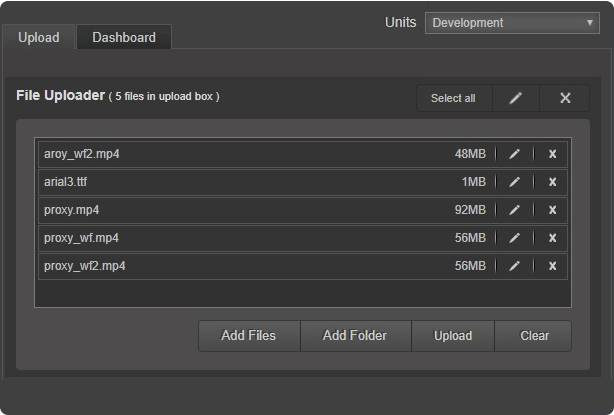Home / Workflows
Workflows

Media can be ingested into eMAM in a number of different ways.
eMAM Feeder Desktop application.
This application allows users to drag and drop, scan folders, or choose individual files for ingest. A user may be assigned multiple ingest profiles with different processing and destinations, so (s)he can choose which one is appropriate for a given set of media. Media can be assigned to one or more categories and projects as needed. The system will keep the file folder structure. The user tags the media, with one or more fields required. Progress can be tracked from the Feeder dashboard. The Feeder app can be downloaded from the eMAM web interface.
Web uploader
Users can drag and drop or select files for ingest directly from the Ingest widget on the web interface. They can choose categories and projects and tag the metadata before starting the process.
Adobe Media Encoder
An extension panel inside Adobe Creative Cloud apps allows users to use the eMAM system from inside their editing and design applications. For Premiere and After Effects users, local media can be ingested directly into editing projects using the media browser. When a project is checked (back) into eMAM, then locally added media is ingested and transcoded using the included Adobe Media Encoder tool.
Live Ingest
Live media streams can be ingested using a variety of third-party tools. When the file is encoded, then it can be used in the eMAM system. Using Drastic Technology’s Net-X Code, media can be ingested and tagged live. In the web interface, an indicator shows which media are incoming live streams.
Other
eMAM can ingest media from a watch folder or from third party integrated tools
- Transcoding
Light-weight proxy copies of media can be generated from any camera, from an integrated local or server-based transcoder, or a command line trigger. eMAM can manage the transcoding process for integrated transcoders from Telestream, Drastic, Ateme, AWS Elemental, and Capella. The transcoders extract metadata and generate H.264 MP4 proxies for video, MP3 for audio, and JPEG for graphics. Organizations can specify the quality of the proxies and allow users to choose from the different quality levels if needed. The transcoding process can be monitored from the Dashboard widget in the web interface. - Metadata tagging
During the transcoding process, embedded metadata detailing key properties of the media (type, size, etc.) are automatically extracted. Additional metadata comes from: manual entered before or after ingest, by AI/ML automated tools, from an XML side car file, or parsed from the file name. For more details, see emamsolutions.com/workflow/organization - File acceleration
eMAM can use common file acceleration processes (Aspera, Signiant, FileCatalyst, and S3 acceleration) to move the original files to the storage faster. - Monitoring
In the eMAM web interface, there is a Dashboard widget. Authorized users can watch the processing of files and other steps. Jobs can be prioritized and resubmitted as needed. - File Storage
eMAM can store media into almost any kind of local or cloud storage system. For the list of prequalified API integrations, please visit emamsolutions.com/techpartners age.

Media management and tagging
AI tagging:
Organizations can now use artificial intelligence/machine learning tools to provide meaningful tags and markers for content previously poorly labelled. Automated indexing can be done for select media to control costs while making the key media accessible. Organizations can now use artificial intelligence/machine learning tools to provide meaningful tags and markers for content previously poorly labelled. Automated indexing can be done for select media to control costs while making the key media accessible
Categories and projects:
Category: Assets can be organized into one or more eMAM categories and subcategories without duplicating media. User groups have restricted access and permissions to categories for security. eMAM can manage all assets of a category together as needed, e.g. archive an entire category.
Project: A collection of assets is grouped into projects for editing or other needs without duplicating the media. Projects can be shared with other users. Editors and designers can access projects from within their Adobe Create Cloud apps (Premiere, After Effect, Photoshop, InDesign, and Illustrator) with advanced tools. Adobe The Project Version widget tracks all of the changes made.

eMAM allows collaboration between technical and non-technical users on creative projects
Video professionals.
Editors and designers can download integrated extension panels for Adobe Creative Cloud apps from the eMAM web interface. They can access the media including all. of the projects and categories of the eMAM system from within their applications. They can search and preview media, review the metadata, view the history, and more. eMAM managed clips or projects can be brought into the timeline along with local media.
The system has full production asset management tools. Projects can be checked into and out of the system. Original and mezzanine edit media can be stored in AWS S3 tiers, NICE, and FSX, Lucid Link, Microsoft Blob, Google GCP, IBM COS, Wasabi, Qumolo, and Alibaba. Editors can edit on original resolution or mezzanine edit media versions by downloading, linking, streaming (Drastic Technology’s Media Reactor) or remote access with Teradici or other tools. Editors have access to all of the media in all of the locations and tiers. An extension in Final Cut allows similar functionality and with partner technologies, Avid editors can collaborate.
Projects can be sent for review and approval with feedback and markers sent from the web interface or from the email links. Projects can be finished with a final conform from local or cloud storage.
Non-technical users
From the web interface, authorized users can search and browse media, add them to projects and create bins. On the preview play, users can add markers and sub clip the media. Users can create a timeline sequence and drag/drop media or sub clips. These can be previewed and shared with others. From the web interface, users can also interact with new or historical editing projects
Still and Motion Graphics Artists
The extension panel in After Effects can support similar workflows including MOGRT files. Panels inside Photoshop, Illustrator, and InDesign allow different creatives to work together.

Deliver:
Finished content can be delivered to any number of destinations with transcoding on demand through FTP or with UDP file acceleration.
Supported destinations include:
CDNs. Content delivery networks power the mass distribution and download of content by storing and sending content in multiple cloud storage locations. These include Akamai and Limelight as well as tools from within cloud platforms including Amazon, Microsoft, and IBM.
Custom web sites. eMAM users can quickly publish one or many assets with a video player to an existing website. A team from eMAM, the customer, or a third party can also develop a new interactive portal with rich media support.
OVP:
eMAM can deliver to third-party player platforms like Brightcove that allow organizations to easily build channels
OTT:
eMAM can deliver media and metadata for publishing to streaming platforms and devices
NEWSROOM:
with the MOS connector, eMAM can link needed media to stories generated in the newsroom system
BROADCAST:
eMAM can put in segments and markers for media and deliver to Morpheus and other platforms

Sharing:
Users can send links of media for a variety of purposes, as summarized in the table. The most popular are:
Review and approval:
An editor can share a project for colleague/customer feedback either within the eMAM system or by email
eBINS:
Mixed media emails with branding for marketing or sharing media
eSHARE:
links to individual videos can be sent by email or through social media
Sequence links:
web interface users can build a timeline/sequence of clips and sub clips and then share with others
eMAM can provide powerful and affordable solutions to power storage and archive needs.
Storage:
eMAM is a full media asset management system, which can manage content in multiple locations and types: DAS, NAS, SAN, cloud storage, and archive. eMAM supports numerous manufacturers, so organizations can choose the best solution to fit the needs for performance and budget. eMAM can manage different storage tiers, allowing an organization to minimize spending or expensive primary storage while preserving easy access to all content.
Archive:
eMAM can manually archive any number of assets, projects, or categories. The system can automatically do so for inactive files after a certain number of days, or once a certain condition is met. eMAM can archive editing projects, completed material, or original camera files from an Adobe extension panel or the web interface. eMAM will make copies of media used in other editing projects before archive to ensure needed media does not go offline. eMAM retains all metadata and proxy copies for archived files, so all media can be quickly found for future needs. Users can restore content from an extension panel or the web interface, with partial restores available from supported third party systems.






